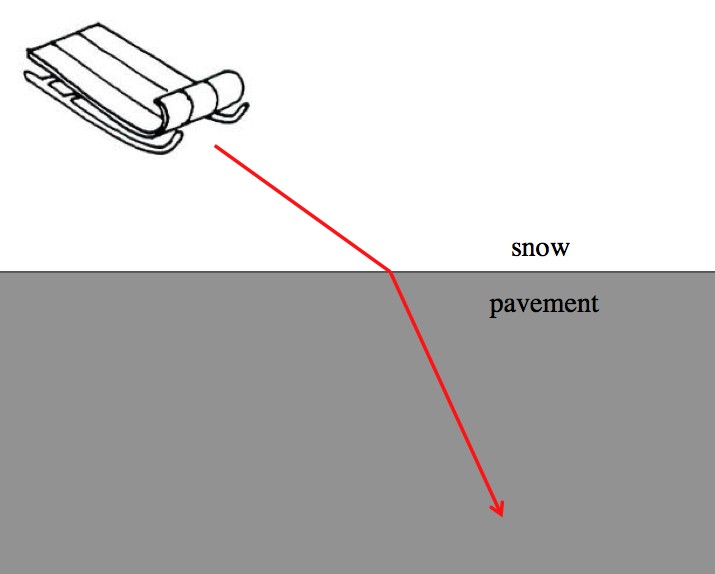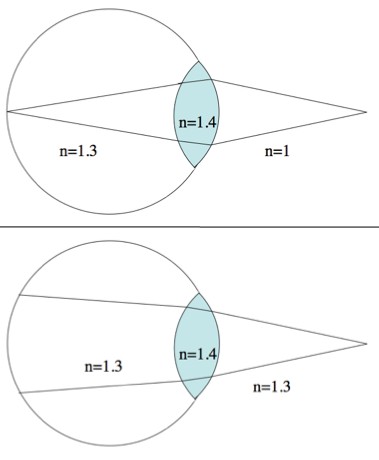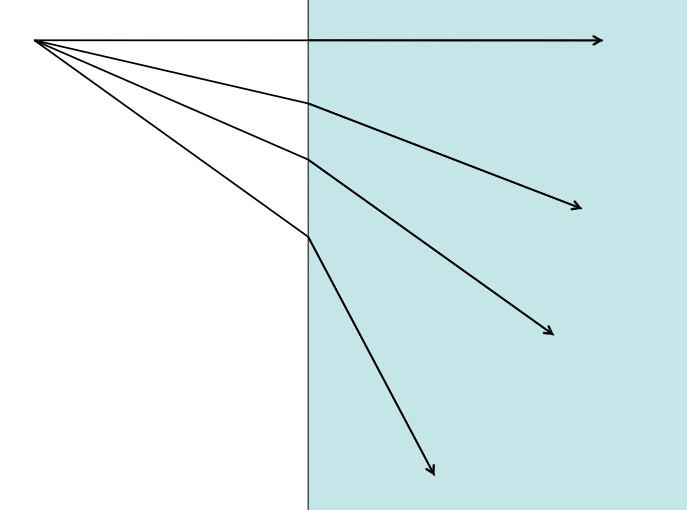Physicist: The speed of light depends on the medium it moves through. So as light moves from air to glass, for example, it slows down. Because light is a little spread out, speeding up or slowing down can make it change direction. When the boundary between mediums is slanted, one side of the wave changes speed first, causing the wave to “swing around”. This change in direction is called “refraction”.

Sleds are faster on snow than pavement. So when the right runner hits the asphalt it slows down, and the sled turns right. As it happens, the rider tends to turn left.
It’s worth noting (because this is a common confusion), that when the speed of light slows down it doesn’t have any profound repercussions for relativity or time travel or anything like that. In fact the reason it slows down is that it’s being absorbed and re-emitted by atoms as it moves through the material. In between atoms it’s still as fast as ever. Picture it as the fastest, stop-and-go traffic evers.
Back to the point. All lenses use refraction to change the direction of light. The surface is curved in such a way that all the light from one direction is directed to a single point (on the focal plane). So without refraction, you’ve got no lensing.
Physicists measure the speed of light through materials using the “index of refraction”, which is defined as where c is the usual speed of light and v is the speed in the material. So, if n=2, then light is traveling through that material at half speed. In general, the shallower the incoming angle and the greater the difference in n’s, the more light will bend. The exact relationship is summed up in Snell’s law.
For those of you keeping score; “Willy Snell” is the second nerdiest name in physics, second only to “Norbert Wiener“.

There's a big difference between the n's of air and your cornea, so the lens bends light very effectively. But, there's very little difference between the n of your cornea and the n of water, so the lens barely has any effect at all.
Light travels through water, the human cornea, and the “aqueous humour” at about the same speed, so they all have nearly equal n’s. Because the index of refraction is so similar, light barely changes direction at all. It’s like sledding from one kind of snow to another, nearly identical, kind of snow. Normally, the light spreading out from a single point in your field of view gets pulled back together, into a single point again, on the back of the eye (top part of the picture).
However, without a functioning lens, the light from a particular point (in your field of view) keeps spreading out, and is projected onto a large area in your eye. That means that you can’t tell exactly where the point is in reality. Objects near each other end up smearing over the same areas on the back of the eye, etc. In other words; it’s blurry.
By the way, in a functioning eye, there’s very little abstraction going on in there. If you were small enough to crawl inside some one’s eye (only try this with close friends) you would actually see a picture of whatever they’re looking at projected onto the back wall of the eye.
Being under water is about as close to not having a cornea as you can come without surgery. In fact, the only reason that you’re able to see anything other than color is that the iris (being fairly small compared to the rest of your eye) forms a pinhole camera. (The image above, though beautiful, is not to scale)
What about goggles? There’s still a couple of medium changes (water, plastic, air) so light still bends. But goggles are held a little away from the eye, so that most of the light you’re seeing has hit the surface head on (meaning a small angle change) instead of at a shallow angle (which causes a big angle change). You’ll notice that if you look at things near the edge of your goggles they’ll be blurrier. So, that’s why.

The shallower the incoming angle, the greater the bending and also the greater the lensing effect, which in this case serves to make things more blurry. Luckily, when we look at things we tend to turn our head toward them, and the angle of the light from straight ahead isn't changed much.
What’s most important is that the lens in your eye is allowed to do what it does, and that requires the proper curvature (check) and the proper difference in indexes of refraction (n=1 and n=1.4), which requires air. Those creatures lucky enough to be able to see both in water and air do it with a combination of mucus goggles, and corneas capable of changing shape dramatically.







Any example of those lucky creatures?
Dolphins, sea lions, and penguins (who only seem blind because they’re so dumb).
good one but ineed more messages………
You given idea for me but i need basic sense EEE department.then only you given for basic tips for me kinte ly i have ask for this help .
I had this question while swimming earlier today and this answered it.
Thank You!
interesting facts but please improve
has answer my confusion
idk why is the line red?
Because why not?